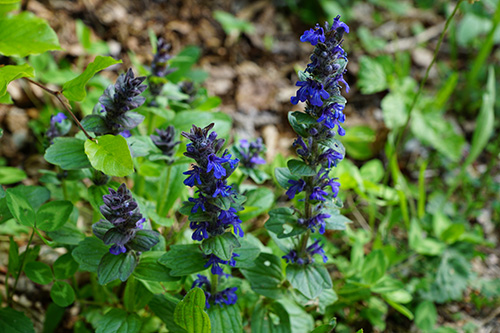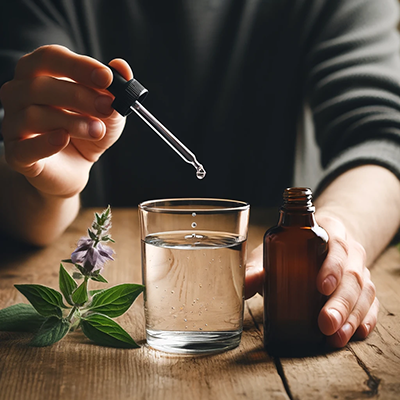Contents
Gardening and landscaping are hobbies that can bring joy to anyone who loves the outdoors. If you’re new to these activities, someone has likely mentioned Bugleweed (Ajuga reptans) as a plant worth considering for your garden or yard space. This ground cover is attractive and versatile enough to enhance any landscape easily.

What Is Bugleweed?
Bugleweed is a perennial herbaceous plant that began in Europe but has since spread to other parts of the world, including North America. It belongs to the Lamiaceae family, including mint, sage, and lavender relatives. The name “bugleweed” comes from its distinctive tubular-shaped flowers resembling those of trumpets or bugles. This plant goes by different names depending on where you are – carpet bugle, common bugle, or burgundy glow.
Appearance and Growth Habits
Bugleweed is a low-growing plant that forms dense mats on the ground. Its striking foliage boasts shades of green, burgundy, bronze, and variegated patterns in some varieties. The leaves are toothed with an arrangement resembling rosettes, adding visual interest to any garden where it’s grown. With its unique appearance and easy maintenance requirements, this hardworking perennial deserves consideration in your landscape design plans!
Bugleweed is a standout plant when it comes to flowering. In late spring or early summer, tall spikes emerge from the foliage adorned with small tubular flowers that add vibrancy and texture to any garden space. The flower colors vary greatly depending on the cultivar – ranging from deep blues and purples to pinks and whites. With such versatility in color options available, it’s no wonder why Bugleweeds blooms are so highly sought after by gardeners everywhere!
How to Care for Bugleweed
To ensure optimal growth, here are some essential tips on caring for your beloved plant:
- It can flourish in full sun and partial shade. However, keeping it partially sheltered from direct light exposure for optimal growth with vibrant foliage and flowers is best.
- This plant’s adaptable nature allows it to thrive in moist, well-draining soil. Once established, though, drought periods won’t pose much trouble for the resilient greenery.
- Establishing a plant requires consistent watering during its initial growth phase. However, once it has taken root, you can allow for brief periods of dryness without harming the plant’s health. Keep this in mind when caring for your greenery!
- Bugleweed is a vigorous grower that requires occasional pruning to prevent it from becoming invasive. Keeping up with this task will help maintain the plant’s tidy appearance by trimming back any overgrowth and spent flower spikes as needed.
- Bugleweed propagation is a straightforward process accomplished through division or stem cuttings. This method allows for easy reproduction of the plant without sacrificing its health and vitality. Its simplicity makes it ideal for those looking to expand their garden collection quickly.
The plant is excellent for companion planting with taller perennials and shrubs. Its unique appearance adds a striking contrast when grouped in the garden. This combination creates a visually stunning display that will impress any visitor to your outdoor space. So why not try it today? You won’t be disappointed!
Health Benefits
- Parts Used: The whole herb.
- Properties: Tonic, Sedative, Astringent.
- What it Affects: Lungs, Heart, Circulation.
Bugleweed is a plant with an exceptional chemical composition with numerous health-promoting properties. From its ability to support hormonal balance to reducing inflammation throughout the body – discover why this herb should be included as part of any natural healing regimen!

Rich in Phytochemicals
Bugleweed has been used for centuries due to its medicinal properties. Its phytochemicals, flavonoids, tannins, and phenolic compounds, are responsible for these benefits. Scientific research has confirmed the impact of these bioactive components on the human body. The results of this investigation showcase how valuable bugleweeds’ potential can be in maintaining good health.
Thyroid Regulation
Bugleweed has been used for centuries in traditional medicine to manage hyperthyroidism – an overactive thyroid gland. The plant contains compounds believed to help regulate the production of hormones responsible for stimulating thyroid activity by suppressing them, thus reducing symptoms associated with this condition, such as rapid heartbeat, anxiety, and weight loss. This makes it popular among those seeking natural alternatives for their healthcare needs. With its proven efficacy backed up by scientific research, bugleweed’s role in promoting overall wellness cannot be ignored!
Anti-Inflammatory Benefits
Bugleweed has been shown to possess potent anti-inflammatory properties that can benefit numerous conditions characterized by chronic inflammation. Flavonoids and other compounds with similar effects help reduce swelling while alleviating symptoms associated with ailments such as arthritis, joint pain, or certain skin disorders. With its ability to relieve these uncomfortable conditions, bugleweed is essential in any holistic treatment regimen for those seeking natural remedies.
Antioxidant Protection
It contains many antioxidants that help neutralize harmful free radicals in the body. These radicals are at fault for causing cellular damage and oxidative stress that can lead to chronic diseases over time. Consuming bugleweed regularly reduces your risk of developing these conditions while promoting overall health and longevity! So why wait? Incorporate this powerful herb into your diet today!
Nervous System Calming
It can also be used as a mild sedative and nervine tonic. Its calming effects on the nervous system make it a superb choice for those seeking natural ways to manage stress or improve sleep quality.
By alleviating anxiety and promoting relaxation, this herb may help individuals find relief from daily pressures without resorting to medications with potentially harmful side effects. Consider incorporating bugleweed into your wellness routine if you’re looking for holistic solutions that work synergistically with other therapies like meditation, exercise, or mindful breathing practices.
Respiratory Health
Bugleweed has been a staple in traditional medicine for remedying respiratory conditions such as coughs, bronchitis, and asthma. Its soothing properties can help alleviate inflammation while relieving congestion, thus promoting overall lung health.
Cardiovascular Support
Bugleweed has been studied for its potential cardiovascular benefits. Research suggests that it may help regulate blood pressure, improve circulation, and lower cholesterol levels – all of which contribute to better heart health and reduced risk of cardiovascular diseases.
Menstrual Support
Bugleweed has been used as a remedy for women experiencing menstrual irregularities and discomfort. It helps regulate the cycle while alleviating symptoms such as cramps or mood swings. This herb is an effective natural alternative to conventional medications that may have side effects. Many women relieve their period woes with bugleweed’s assistance without compromising safety or efficacy.
Safety Measures
Bugleweed is a powerful herb with numerous health benefits. However, it’s essential to use caution when incorporating this plant into your wellness routine. Consulting an experienced professional such as a doctor or herbalist can help you use bugleweed properties safely and effectively, especially if you have preexisting medical conditions or take medications regularly.
Side Effects
Bugleweed may cause adverse reactions in some individuals due to its prospective interactions with other medications or health conditions.
Thyroid Interference: It has been used as a medicinal herb for centuries due to its ability to regulate thyroid hormones in individuals with hyperthyroidism. However, caution must be exercised when using this plant-based remedy if you have hypothyroidism or are taking prescription drugs that affect your thyroid gland – it could lead to further imbalances and worsen symptoms rather than alleviate them! Always consult an expert before trying new supplements or natural treatments, especially those related to sensitive bodily functions like the endocrine system.
Gastrointestinal Disturbances: Bugleweed consumption may trigger gastrointestinal discomforts such as nausea, upset stomach, and diarrhea. These symptoms are more likely to occur in individuals with sensitivities or when the herb is consumed excessively.
Allergic Reactions: Like any plant, it can trigger allergic reactions in some individuals. These responses may range from mild skin irritations to severe anaphylaxis and difficulty breathing. If you know you have sensitivities towards other plants within the Lamiaceae (mint family), caution should be exercised when using bugleweed.
Drug Interactions: This plant is known for its bioactive compounds that may interact with certain medications. This could lead to enhanced effects from sedative drugs or interfere with those used to control heart rate and blood pressure. If you take any prescription medicines, especially those affecting the thyroid, nervous system, or cardiovascular health, seeking professional advice before using the herb is essential.
Pregnancy and Breastfeeding: The safety of bugleweed during pregnancy and breastfeeding is not well-established in research. Therefore expectant mothers or nurses should avoid using this herb unless a qualified healthcare provider advises otherwise.
Not Pet-Friendly: Bugleweed is not recommended for pets, particularly cats and dogs, as it may cause adverse reactions or toxicity. Pet owners must be cautious when introducing new plants into their homes.
Responsible Use and Precautions

To guarantee safe usage and reduce the likelihood of side effects while using bugleweed, it is essential to take into account these precautions:
Before using bugleweed as an herbal remedy, consult with a healthcare professional. This is particularly important if you have underlying medical conditions, are taking medications, are breastfeeding, or are pregnant. Seek guidance from a competent healthcare practitioner or herbalist for optimal results and safety measures.
Following proposed dosages and avoiding prolonged or excessive use is crucial to minimize the risk of side effects from medication usage. Adhering to these parameters can help ensure a safer interaction with your prescription drugs.
Bugleweed can cause adverse reactions in some individuals. Suppose you experience any negative effects while using this herb. In that case, it is essential to terminate use and seek medical guidance from a healthcare professional immediately.
This plant is not a substitute for professional medical care. Do not attempt to self-diagnose or treat severe health conditions without consulting your doctor first. This herb should only be used under the guidance of an experienced practitioner who can provide proper dosage and monitoring. Seeking expert advice will ensure you receive appropriate treatment while minimizing any potential risks of using this plant medicinally. Remember: Your safety comes first!
Preparation and Dosage
- Infusion: Steep for 5 to 15 minutes and take 6 ounces frequently.
- Tincture: Take ½ to one teaspoon frequently.
- Fluid Extract: Take ¼ to one teaspoon frequently.
- Powder: Take 5 to 10 #0 capsules (30 to 60 grains) frequently.
Health Disclaimer: The information on this website is for educational uses only and is not a substitute for professional medical advice. Always consult an authorized healthcare provider for any health concerns before using any herbal or natural remedy. We do not establish, treat, cure, or prevent any disease. Reliance on any material from this website is solely at your own risk. We are not responsible for any adverse effects resulting from the use of information or products mentioned on this website.
REFERENCES
- Vance Ferrell Harold M. Cherne, M.D. The Natural Remedies Encyclopedia [Book]. – Altamont, TN: Harvestime Books, 2010. – Vol. Seventh Edition: 7: pp. 148.
- Roemheld-Hamm B. (2005). Chasteberry and Other Herbal Therapies for Premenstrual Syndrome (PMS). Journal of Midwifery & Women’s Health, 50(4), 292-299.
- Brock C, Whitehouse J, Tewfik I, Towell T. (2014). American Herbal Pharmacopoeia Botanical Pharmacognosy – Microscopic Characterization of Botanical Medicines. CRC Press. ISBN: 9781439854514
- European Medicines Agency. (2010). Assessment report on Lycopus europaeus L., herba. EMA/HMPC/40016/2009.
- National Institutes of Health (NIH). (2021). Bugleweed. National Center for Complementary and Integrative Health.
- Drugs.com: https://www.drugs.com/npp/bugleweed.html
- ClinicalTrials.gov. (n.d.). Search for “bugleweed” or “Lycopus.” https://clinicaltrials.gov
- PubMed. (n.d.). Search for “bugleweed” or “Lycopus.” https://pubmed.ncbi.nlm.nih.gov
